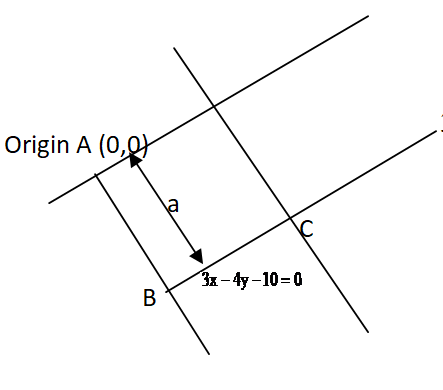
Vertex of a square is at the origin and it’s one side lies along the line \[3x - 4y - 10 = 0\]. Find the area of the square.
Answer
567.6k+ views
Hint: For finding the area of the square, distance is calculated from origin to line $3x - 4y - 10 = 0$ . This will be the side of the square. Once you know the side length, square it to get the area of the square, as the area of the square is square of its side length.
Complete step by step answer:
Let us start the solution to the above question by drawing a representative diagram of the situation given in the question.

As one of the sides of the square is \[3x - 4y - 10 = 0\] and origin does not lie on this line but the origin is one of the vertices. So, the origin must lie on the opposite side and the distance of the origin from the given line is equal to the side length of the square.
The same can be seen from the diagram also, that AB is one of the sides of the square and is the distance between the origin and the line BC whose equation is \[3x - 4y - 10 = 0\].
Now to find the length of the side AB, we will use the formula of the perpendicular distance of a point from a line.
We know that the distance of the point $\left( {{x_1},{y_1}} \right)$ from the line \[ax + by + c = 0\] is $\left| {\dfrac{{a{x_1} + b{y_1} + c}}{{\sqrt {{a^2} + {b^2}} }}} \right|$.
Therefore, the perpendicular distance of $\left( {0,0} \right)$ from \[3x - 4y - 10 = 0\] is:
$ \Rightarrow $ $\left| {\dfrac{{a{x_1} + b{y_1} + c}}{{\sqrt {{a^2} + {b^2}} }}} \right|$$ = \left| {\dfrac{{ - 10}}{{\sqrt {{3^2} + {4^2}} }}} \right| = \dfrac{{10}}{{\sqrt {25} }} = \dfrac{{10}}{5} = 2$
So, the side length of the square is $2$ units. We know that the area of the square is equal to the square of its side.
Area of the square$ = {a^2} = {2^2} = 4$ square unit
Therefore, the area of the square is $4$ square units.
Note:
The solution can be done by an alternative method, you can use the equation of the line $3x - 4y - 10 = 0$ to get the equation of the perpendicular line using the point that the product of the slopes of a perpendicular line is $ - 1$ and passing through the origin. After getting the perpendicular equation, find the point of intersection. Calculate the distance between two points to get the length of the square.
Complete step by step answer:
Let us start the solution to the above question by drawing a representative diagram of the situation given in the question.

As one of the sides of the square is \[3x - 4y - 10 = 0\] and origin does not lie on this line but the origin is one of the vertices. So, the origin must lie on the opposite side and the distance of the origin from the given line is equal to the side length of the square.
The same can be seen from the diagram also, that AB is one of the sides of the square and is the distance between the origin and the line BC whose equation is \[3x - 4y - 10 = 0\].
Now to find the length of the side AB, we will use the formula of the perpendicular distance of a point from a line.
We know that the distance of the point $\left( {{x_1},{y_1}} \right)$ from the line \[ax + by + c = 0\] is $\left| {\dfrac{{a{x_1} + b{y_1} + c}}{{\sqrt {{a^2} + {b^2}} }}} \right|$.
Therefore, the perpendicular distance of $\left( {0,0} \right)$ from \[3x - 4y - 10 = 0\] is:
$ \Rightarrow $ $\left| {\dfrac{{a{x_1} + b{y_1} + c}}{{\sqrt {{a^2} + {b^2}} }}} \right|$$ = \left| {\dfrac{{ - 10}}{{\sqrt {{3^2} + {4^2}} }}} \right| = \dfrac{{10}}{{\sqrt {25} }} = \dfrac{{10}}{5} = 2$
So, the side length of the square is $2$ units. We know that the area of the square is equal to the square of its side.
Area of the square$ = {a^2} = {2^2} = 4$ square unit
Therefore, the area of the square is $4$ square units.
Note:
The solution can be done by an alternative method, you can use the equation of the line $3x - 4y - 10 = 0$ to get the equation of the perpendicular line using the point that the product of the slopes of a perpendicular line is $ - 1$ and passing through the origin. After getting the perpendicular equation, find the point of intersection. Calculate the distance between two points to get the length of the square.
Recently Updated Pages
Master Class 8 Maths: Engaging Questions & Answers for Success

Class 8 Question and Answer - Your Ultimate Solutions Guide

Master Class 7 Maths: Engaging Questions & Answers for Success

Class 7 Question and Answer - Your Ultimate Solutions Guide

Master Class 6 Maths: Engaging Questions & Answers for Success

Class 6 Question and Answer - Your Ultimate Solutions Guide

Trending doubts
What is meant by exothermic and endothermic reactions class 11 chemistry CBSE

Which animal has three hearts class 11 biology CBSE

10 examples of friction in our daily life

One Metric ton is equal to kg A 10000 B 1000 C 100 class 11 physics CBSE

1 Quintal is equal to a 110 kg b 10 kg c 100kg d 1000 class 11 physics CBSE

Difference Between Prokaryotic Cells and Eukaryotic Cells




